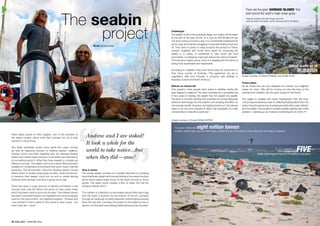
Seabin project helps clean Hong Kong marinas
- 1. The seabin project Words Rachel Forrest Hebe Jebes spoke to Pete Cegliksi, one of the founders of the seabin project, about what their concept can do to help marinas in Hong Kong. Two West Australian surfers have spent four years coming up with an ingenious solution to floating rubbish—seabins. Andrew Turton and Pete Ceglinksi saw the damage floating plastic and rubbish were causing in local waters and decided to do something about it. What they have created is a simple yet effective concept. The seabin works as a water filtering system suitable for condensed environments like yacht clubs, marinas and ports. The bin basically ‘vacuums’ floating rubbish, oil and debris which is usually swept away by tides, wind and storms. In essence their design could put an end to waste leaving harbours and marinas, and stop it going out to sea. There has been a huge amount of interest worldwide in the concept with over 80 million hits alone on their online video which has been used to promote the idea. The interest shown has been overwhelming but only highlights the concern people have for the environment. As Ceglinksi explains, “Andrew and I are stoked! It took a while for the world to take notice...but when they did—wow!” Andrew and I are stoked! It took a while for the world to take notice...but when they did—wow! How it works The simple design consists of a cylinder attached to a floating dock that floats upright with one end sitting on the water’s surface and a shore-based water pump on the dock running on shore power. The water pump creates a flow of water into the bin bringing rubbish with it. The rubbish is collected in a removable natural-fibre catch bag and the water is sucked out the bottom of the bin, pumped through an (optional) oil-water separator before being pumped back into the sea. Currently, the power for the water pumps is electric, but the team are looking at alternative sources of power. Challenges The seabin is still at the prototype stage, but orders will be taken at the end of the year (2016). At a cost of USD $3,825.00 per unit and running 24 hours a day, it is a worthwhile investment for yacht clubs and marinas struggling to deal with floating trash and oil. They have no plans to mass produce the product in China. Instead, Ceglinksi and Turner have opted for producing the seabin in a variety of continents to help boost the local economies, cut shipping costs and reduce the carbon footprint. This has led to higher prices, but it is in keeping with the ethos of being more sustainable and responsible. According to Ceglinksi, they have future plans for production in their home country of Australia. “The agreement we are in negotiation with now includes a company with facilities in Australia, Europe and North America.” Effects on marine life One question many people have asked is whether marine life gets trapped in seabins? The team admitted it’s a possibility but in four years of testing, the seabin has not caught any sealife. The team is currently working with scientists on incorporating fish deterrent technology into the seabins and studying the effect on microscopicsealife.However,asCeglinksipointsout,“Asmarinas seem to be the most polluted of areas, the probability of a high concentration of sea life is quite low.” Future plans So far, these bins are only designed for marinas, but Ceglinksi hopes for more. “We will be moving out into the bays of the marinas and hopefully into the open oceans in the future.” The seabin is cheaper and lower maintenance than the time- consuming and laborious task of collecting floating debris from the water. Hong Kong has ever-increasing troubles with ocean pollution and the seabin may be able to at least partially address part of the problem—cleaning up our marinas one floating bin at a time. Image courtesy of Susan White/USFWS The ocean is filled with eight million tonnes of plastic bottles, bags, toys and other plastic rubbish end up in the world's oceans each year according to scientists. This is enough to fill FIVEplastic carrier bags for every foot of coastline on the planet. Island made up of RUBBISH These are located in the Indian Ocean, and in the north and south of the Pacific, and the north and south of the Atlantic There are five giant ‘GARBAGE ISLANDS’ that swirl around the world's major ocean gyres. Image courtesy of Hamid Shafeeu and Smile Amith SUSTAINABILITY SUSTAINABILITY 5150 HEBE JEBES • MAR/APR 2016
- 2. 52 HEBE JEBES • MAR/APR 2016 Image courtesy of Hamid Shafeeu and Smile Amith SUSTAINABILITY SUSTAINABILITY 5352 HEBE JEBES • MAR/APR 2016 海上垃圾桶計劃 撰文:Rachel Forrest Hebe Jebes 訪問了海上垃圾桶計劃(seabin project)的 其中一名倡議者 Pete Cegliksi,談談這概念如何幫助保護香 港的海岸。 兩位西澳洲衝浪者花了四年時間研究如何解決海上垃圾漂浮的 問題:海上垃圾桶。Andrew Turton 和 Pete Ceglinksi 眼見在 海上漂浮的塑膠和垃圾問題越來越嚴重,便決定想辦法解決。 他們想到了一個既簡單又有效的方法。海上垃圾桶可以發揮過 濾系統的作用,適合較為擠迫的環境,例如遊艇會、碼頭和港 口。垃圾桶主要「吸走」被潮浪和風帶來的漂浮垃圾、油污和 碎片。在本質上,他們的設計可以令廢料不再離開海港和碼頭 排出大海。 他們的概念在全球引起廣泛興趣,單是他們宣傳這個概念的 短片已在網上被點擊收看8000萬次。引起的興趣勢不可擋, 但最重要還是顯示了人們對環境的關注。正如 Ceglinksi 說: 「Andrew和我都感到很鼓舞!可能要花一點時間讓世界關 注⋯⋯但當人們關注的時候 ——嘩!」 如何運作 這個簡單的設計包括一個連接浮塢的垂直圓桶,其中一邊露出 水面,而浮塢上的一個水泵由岸上發電。水泵形成一股水流連 同垃圾注入圓桶。 那些垃圾會由一個可拆除的天然纖維袋收集,而海水會由圓桶 的底部經油污分解裝置泵到大海。目前水泵以電力發動,但該 團隊正尋找另一種替代能源。 挑戰 目前海上垃圾桶仍在原型階段,但2016年底將開始接受預 訂,每部價值約3,825美元,可24小時運作,對需要解決漂 浮垃圾和油污的遊艇會來說是一項值得的投資。Ceglinksi和 Turner沒有打算在中國大量生產,相反,他們計劃在不同的 地區生產海上垃圾桶,以協助當地發展經濟、降低運輸成本 和減少碳足跡。雖然此舉增加了成本,但能貫切可持續和負 責任的精神。Ceglinksi透露,他們未來計劃在家鄉澳洲進行生 產:「我們正與來自澳洲、歐洲和北美洲的廠家協商。」 對海洋生態的影響 許多人都有一個疑問,就是海洋生物會否被困於海上垃圾 桶?他們承認的確有這個可能性,但過去四年的測試當中, 海上垃圾桶並沒有捕捉到任何生物。團隊正與科學家研究在 海上垃圾桶內設置驅趕魚類的技術,並研究對海洋微生物的 影響。然而,Ceglinksi 指出:「由於碼頭是污染最嚴重的區 域,有大量海洋生物聚集的可能性是很低的。」 未來大計 到目前為止,這些垃圾桶只為碼頭而設計,但 Ceglinksi 希望 未來可做得更多。「我們正研究在碼頭對出的海灣使用這個裝 置,還希望未來可以在海洋使用。」 相對於花費大量人力和物力在海上撈走漂浮的垃圾,海上垃 圾桶的費用更便宜,所需的保養也較少。香港的海洋污染情 況越來越嚴重,或許海上垃圾桶能有助解決部份問題——使 用一個海上垃圾桶清理我們的碼頭。